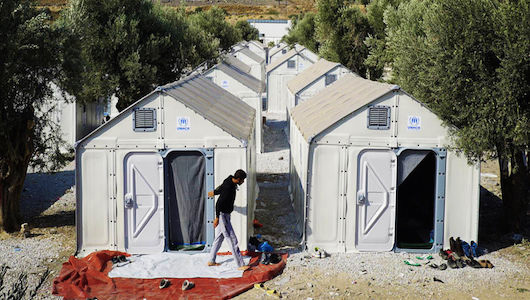Ikea Builds 10,000 Shelters for Syrian Refugees
 Showing no signs of stopping, the surge of Syrian refugees poses many issues for European and Middle Eastern countries, mainly housing, as the Northern hemisphere gears up for winter.
Showing no signs of stopping, the surge of Syrian refugees poses many issues for European and Middle Eastern countries, mainly housing, as the Northern hemisphere gears up for winter.
According to the International Organization for Migration (IOM), since the start of 2015 more than 750,000 migrants have arrived by sea to Europe. The large amount of refugees has not only sparked international interest but also a crisis as many European countries struggle to cope with the influx of refugees fleeing to Europe for a better life.
The IKEA Foundation, in collaboration with Better Shelter, has partnered to create safer, more reliable housing options for the thousands of Syrian refugees fleeing to Europe.
Focusing on cost-effectiveness, IKEA developed a tent that costs approximately $1,000. The tent can comfortably house a family of five and only takes four to eight hours to assemble. The structures come in two sizes: 57 square feet or 188 square feet of living space and will last up to three years. Comparatively, the United Nations (UN) shelters only last three months.
“This is just a tiny part of humanitarian aid. But it’s an important one when it comes to allowing displaced people to live with dignity,” said Johan Karlsson, the main Swedish Industrial designer.
Additionally, the shelters are equipped with solar panels that are durable against extreme temperatures. The solar panels were developed in response to the cited lack of electricity among refugee shelters.
A woman by the name of Mayada, one of many refugees seeking asylum, came to a camp in Jordan ten months ago. She said she never imagined having to live without the most basic necessities, particularly electricity.
“Nowadays electricity is life, and without it even the most simple things become a struggle,” she told visitors from the UN Refugee Agency.
The absence of light and power makes everyday living activities difficult, as well as dangerous, particularly for women. Mayada’s daughter is too scared to go to the bathroom at night and has to wake her parents to accompany her. The solar panels will help to quell their fears.
With the arrival of winter and light disappearing earlier in the day, basic daily functions, as well as communication among refugees, become more difficult.
“You can’t visit friends, the kids can’t do their homework. By nine or 10 o’clock most of the camp is in bed,” Mayada said.
In addition to the solar panels, the tents will also have mosquito nets, windows and a door that locks. The lock option for doors is a simple solution to help prevent sexual assault among refugee women traveling across the Middle East and Europe.
“People tell us it will make a huge difference to them just to be able to switch a light on again, making them feel more at home,” UN Refugee Agency Energy Advisor Paul Quigley said.
The UN has ordered 10,000 of the units to help reduce the Syrian housing crisis. Europe will receive 755 units and 2,600 homes will go to Iraq.
Mayada said when electricity is made more available to the refugee camps, she will no longer have to put on a brave face for the sake of her kids, particularly her daughter.
“I wish I could give [IKEA] all a big kiss between their eyes! It will mean everything to us!” Mayada said.
– Alyson Atondo
Sources: PBS, UNHCR, Business Insider, BBC
Photo: Google Images
